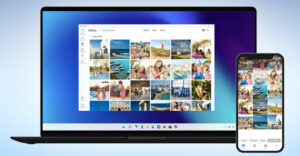Google has begun taking pre-orders for its first foldable phone with an eye toward shipping the gadget in June.
The Pixel Fold will sell for US$1,799, the same price as its chief competitor, the Samsung Galaxy Fold 4.
Google is coming to the foldable market late — although not as late as Apple, which doesn’t have a foldable yet — but it’s taking advantage of its timing by targeting some of the perceived deficiencies of the Galaxy Fold.
Google’s folding phone, for example, is thinner and has a wider body for easier handling. The wider body also allows for a better aspect ratio for viewing its front and interior OLED displays.
“The Pixel stands out by having a wider aspect ratio. That is ideal for content consumption,” observed Brad Akyuz, a mobile industry analyst with Circana, a global market research firm.
“The Samsung Fold has more of a square screen, so you get black bars when you’re watching content on it,” he told TechNewsWorld.
“When closed, the Pixel matches the dimensions of a regular phone with the benefit of the fold,” added Bob O’Donnell, founder and chief analyst with Technalysis Research, a technology market research and consulting firm.
“The Samsung is a little taller and skinnier,” he told TechNewsWorld.
First Gen Blues?
At the heart of the Pixel Fold is the Google Tensor G2 processor, which Akyuz asserts isn’t as powerful as the chip used in its competition. “The Galaxy Fold runs on the market’s top-of-the-line silicon,” he said. “The Pixel Fold uses its own chipset, which is not on par with what Samsung uses.”
In the past, he noted, Pixel phones have had issues with their silicon. “We don’t know that’s going to happen with the Pixel Fold, but I’d say there’s greater peace of mind on the Galaxy Fold side,” he added.
He also pointed out that the Pixel Fold is a first-generation device. “The Samsung Fold is in its fourth iteration,” he explained. “Samsung has gone through a lot of headaches that Google might have to go through.”
“We don’t know what kind of problems Pixel Fold customers might have and how Google might be addressing them,” he added. “With the Galaxy Fold, we have a pretty good idea of Samsung’s game plan.”
Nevertheless, the Pixel Fold edges out its competition in some other areas. It has a bigger battery, for example, and three cameras — a 48-megapixel main sensor, a 10.8 MP ultrawide camera, and a 10.8 MP telephoto camera with a 5x optical zoom and 20x digital zoom. It can also snap pictures from a distance with a palm gesture.
Foldable Phones Appeal to Business Travelers
Still, that $1,800 price tag limits the audience for this Google offering and its foldable brethren.
“At the moment, we only see early adopters buying folding phones,” said Tim Bajarin, president of Creative Strategies, a technology advisory firm in San Jose, Calif.
“They are still looked at as a novelty, although they are starting to turn the corner,” he told TechNewsWorld. “As prices come down and more are introduced, these folding phones could become a larger market in the future.”
Foldables also appeal to businesspeople on the move. “I’ve found that when I travel, I can use my foldable and not carry my laptop anymore,” said Nabila Popal, a research director at IDC Worldwide Tracker Team.
“I found I can be productive. It does make a difference,” she told TechNewsWorld.
“Foldables aren’t for everyone,” O’Donnell admitted, “but for some people, they’re a slam dunk because you get the equivalent of a smartphone and a tablet in a single device. That’s pretty cool.”
“I love mine,” he continued. “I can look at documents on the phone and actually read them.”
Akyuz noted that Samsung’s Fold line benefited from discontinuing the Galaxy Note series in 2022. “Z Fold was able to attract many Galaxy Note customers,” he said, “who are known for buying these devices for business use, for productivity purposes.”
“The larger real estate on the display side allows for a much richer user experience, especially for applications designed for this form factor,” he added.
Bright Spot in Bleak Market
In addition to price, durability appears to be a barrier to some consumers entering the foldable fold. “You still have many consumers not fully convinced about the durability of foldables,” Akyuz said.
He recalled a recent Circana survey taken at a trade show that found of those consumers not interested in buying a foldable smartphone, 30% said durability was a driver for not considering a foldable smartphone.
“Two years ago, that figure was 40%,” he observed. “Samsung has done a really good job of improving the form factor, making it a lot more durable, but has also given consumers peace of mind when it comes to servicing the device.”
While foldables remain a niche product, they are a bright spot in the smartphone market. “The smartphone industry has been going through a consecutive quarter-to-quarter decline,” Popal said. “In 2022, we saw a 12% drop in the market, and in the first quarter of 2023, a 15% drop. Within that, however, we’ve seen the foldable segment grow at a fast rate, although it’s from a small base.”
“Three years ago, a lot of people questioned whether foldables were going to be a real trend or a fad, something that’s cool but will die out like 3D TVs,” she continued. “From what we’ve seen in the new products over the last year or so and the pickup — 100% growth in 2022 — foldables have been a silver lining.”
Popal acknowledged that the technology has a long way to go but believes the form factor is here to stay.
“Consumers like it,” she said, “and when the software catches up to this new hardware, we’ll see it become more popular.”
Without Apple in the market, she noted that IDC expects 3.5% of the smartphone market — 50 million units — will be foldables by 2027. “If Apple enters the segment at any point in the next five years,” she added, “that number will skyrocket for sure.”
























































